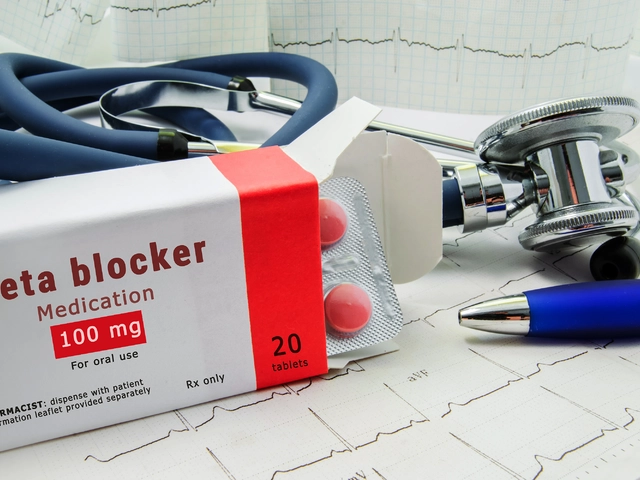Antidepressant Comparison Tool
Select your primary concern and symptoms to get a recommendation on the best antidepressant option:
Cymbalta is a brand name for duloxetine, an SNRI (serotonin‑norepinephrine reuptake inhibitor) approved by the FDA in 2004 for major depressive disorder, generalized anxiety disorder, diabetic peripheral neuropathy, fibromyalgia and chronic musculoskeletal pain. While it’s praised for treating both mood and pain, many patients wonder if another drug might suit them better. This guide walks through the key facts, stacks Cymbalta against the most common alternatives, and gives a practical decision framework.
Quick Takeaways
- Cymbalta blocks the reuptake of both serotonin and norepinephrine, offering dual‑action relief.
- Typical dose: 30‑60mg daily; half‑life about 12hours.
- Common side‑effects: nausea, dry mouth, dizziness, heightened blood pressure.
- Cost: generic duloxetine is cheaper than the brand, but still higher than many SSRIs.
- Best for patients needing both mood and pain control; otherwise consider SSRIs, other SNRIs, or atypical agents.
How Cymbalta Works
Duloxetine inhibits the reuptake of serotonin (5‑HT) and norepinephrine (NE) at neuronal synapses. By raising the levels of both neurotransmitters, it improves mood regulation and modulates pain pathways in the spinal cord. This dual mechanism distinguishes it from pure SSRIs (which target only serotonin) and from tricyclic antidepressants that affect many more receptors.
Key Attributes of Cymbalta
- Class: SNRI
- Approved indications: MDD, GAD, diabetic neuropathy, fibromyalgia, chronic musculoskeletal pain
- Usual adult dose: 30mg once daily (can increase to 60mg)
- Metabolism: Liver (CYP1A2, CYP2D6)
- Half‑life: ~12hours (steady state in 3days)
- Common adverse events: nausea (15‑20%), dry mouth, constipation, insomnia, increased blood pressure
- Contra‑indications: uncontrolled narrow‑angle glaucoma, MAOI use within 14days, severe hepatic impairment
Major Alternatives to Consider
Below are the most frequently prescribed drugs that sit in the same therapeutic space as Cymbalta. Each has a distinct pharmacologic profile.
Sertraline is an SSRI (selective serotonin reuptake inhibitor) widely used for depression, anxiety, PTSD and OCD. It blocks only serotonin, offering a cleaner side‑effect profile for many. Venlafaxine is a second‑generation SNRI that at low doses mainly affects serotonin, while higher doses engage norepinephrine, making it dose‑responsive for pain. Amitriptyline is a tricyclic antidepressant (TCA) that blocks serotonin and norepinephrine reuptake plus several other receptors, often used off‑label for neuropathic pain. Escitalopram is an SSRI marketed for depression and generalized anxiety, known for minimal drug‑interaction risk. Bupropion is a norepinephrine‑dopamine reuptake inhibitor (NDRI) that avoids sexual side‑effects but isn’t effective for anxiety. Milnacipran is an SNRI approved in some countries for fibromyalgia; it has a stronger norepinephrine effect than duloxetine.
Side‑By‑Side Comparison
| Drug | Class | Primary Indications | Typical Dose Range | Common Side‑effects | Approx. Monthly Cost (AU$) |
|---|---|---|---|---|---|
| Cymbalta | SNRI | Depression, anxiety, neuropathic pain, fibromyalgia | 30‑60mg daily | Nausea, dry mouth, insomnia, ↑BP | 45‑65 (generic) |
| Sertraline | SSRI | Depression, anxiety, PTSD, OCD | 50‑200mg daily | Diarrhea, sexual dysfunction, anxiety | 15‑25 |
| Venlafaxine | SNRI | Depression, anxiety, chronic pain (high dose) | 75‑375mg daily | Hypertension, nausea, sweating | 30‑45 |
| Amitriptyline | TCA | Depression, migraine prophylaxis, neuropathic pain | 25‑150mg nightly | Weight gain, drowsiness, anticholinergic effects | 10‑18 |
| Escitalopram | SSRI | Depression, GAD | 10‑20mg daily | Nausea, insomnia, sexual dysfunction | 20‑30 |
| Bupropion | NDRI | Depression, smoking cessation | 150‑300mg daily | Insomnia, dry mouth, tremor | 25‑40 |
| Milnacipran | SNRI | Fibromyalgia, depression (in some regions) | 50‑100mg daily | Headache, nausea, tachycardia | 70‑90 |
Pros and Cons: When Cymbalta Shines
Pros
- Effective for both mood and chronic pain - a single pill covers two problems.
- Relatively fast onset for pain relief (often within 1‑2 weeks).
- Lower sexual dysfunction rates than many SSRIs.
Cons
- Higher rate of nausea, especially at treatment start.
- Can raise blood pressure; requires regular monitoring.
- Cost higher than generic SSRIs, though still affordable in Australia thanks to PBS subsidies.
Choosing the Right Antidepressant: Decision Checklist
- Primary symptom driver: If pain is a dominant issue, prioritize an SNRI (Cymbalta, Venlafaxine, Milnacipran) or a TCA (Amitriptyline).
- Side‑effect tolerance: Patients sensitive to sexual dysfunction may favor Cymbalta or Bupropion; those wary of hypertension should avoid high‑dose Venlafaxine.
- Drug‑interaction profile: Check CYP metabolism. Cymbalta (CYP1A2, CYP2D6) interacts with some antifungals and SSRIs, while Escitalopram has fewer interactions.
- Cost & insurance coverage: Generic sertraline and amitriptyline are the cheapest; evaluate PBS listings for your situation.
- Comorbid conditions: History of seizures cautions against Bupropion; cardiac disease advises against high‑dose Venlafaxine.
Managing Common Side‑effects
Whatever drug you start, a few practical steps can smooth the journey.
- Take with food: Reduces nausea from Cymbalta and venlafaxine.
- Gradual titration: Begin at the lowest dose and increase weekly; many patients tolerate 30mg of Cymbalta after a 1‑week lead‑in.
- Monitor BP: Check every 2‑4 weeks for the first 3 months if on an SNRI.
- Stay hydrated: Helps with dry mouth and constipation.
- Switching strategy: If moving from an SSRI to Cymbalta, employ a 1‑2 week washout to avoid serotonin syndrome.
Related Concepts and Next Steps
Understanding antidepressant choice often leads to broader topics:
- Major depressive disorder (MDD): Diagnostic criteria, prevalence worldwide.
- Neuropathic pain pathways: How serotonin and norepinephrine modulate spinal transmission.
- Pharmacogenomics: CYP2D6 polymorphisms that affect duloxetine metabolism.
- Psychotherapy integration: CBT or ACT combined with medication for faster remission.
- Withdrawal management: Tapering schedules to avoid discontinuation syndrome.
Readers looking for deeper dives can explore "CYP2D6 testing for antidepressants" or "non‑pharmacologic pain management" as logical follow‑ups.

Frequently Asked Questions
Can I take Cymbalta with an SSRI?
Combining an SNRI with an SSRI increases the risk of serotonin syndrome. Doctors usually require a washout period of at least 5‑7 days between the two, unless the dose is very low and the patient is closely monitored.
Why does Cymbalta cause nausea more than other antidepressants?
Duloxetine’s dual inhibition of serotonin and norepinephrine stimulates the chemoreceptor trigger zone in the brainstem, which can provoke nausea. Taking the tablet with food and starting at 30mg helps most patients avoid this side effect.
Is Cymbalta safe for older adults?
Older adults can use Cymbalta, but dose adjustments (often 30mg) are recommended because metabolism slows with age and the risk of hyponatremia and falls rises. Regular BP and electrolytes checks are advised.
How does Cymbalta compare to Venlafaxine for chronic pain?
Both are SNRIs, but duloxetine has FDA approval specifically for diabetic neuropathy and fibromyalgia, giving it a more established evidence base for those conditions. Venlafaxine can be effective at higher doses, yet it carries a stronger risk of hypertension.
What should I do if I miss a dose of Cymbalta?
Take the missed tablet as soon as you remember, unless it’s almost time for the next dose. In that case, skip the missed one and continue with your regular schedule. Doubling up can increase side‑effects and isn’t recommended.
Can Cymbalta help with anxiety even if I don’t have depression?
Yes. Cymbalta is approved for generalized anxiety disorder (GAD) and works well for patients whose anxiety co‑exists with chronic pain. Dosage typically starts at 30mg daily and may be increased based on response.







George Embaid
September 27, 2025 AT 21:51Hey folks, just wanted to point out that when you’re weighing Cymbalta against SSRIs, consider the dual action on both serotonin and norepinephrine. It’s a solid option for people juggling both mood and chronic pain, especially if you’ve tried an SSRI and still have aches. Also, don’t forget to check blood pressure periodically – the SNRI class can nudge it up.
Meg Mackenzie
October 9, 2025 AT 18:25Listen, the pharma giants don’t want you to know that the nausea from Cymbalta is actually a hidden signal of brain chemistry manipulation. They push it as "dual‑action" while quietly tracking how many of us develop hypertension. I’ve seen patterns in the data that suggest a deliberate push to get us hooked on a pricey brand rather than a cheap generic.
Shivaraj Karigoudar
October 21, 2025 AT 15:00Alright, let’s dive deep into the pharmacodynamic intricacies of duloxetine versus its counterparts. First, duloxetine’s inhibition constants for SERT and NET are in the low nanomolar range, which translates to a robust elevation of both neurotransmitters in the synaptic cleft. This bi‑modal mechanism is why clinicians often favor it for comorbid neuropathic pain and depressive phenotypes.
Second, the metabolic pathway involves CYP1A2 and CYP2D6, making it susceptible to drug‑drug interactions with common antifungals and certain SSRIs; a wash‑out period of at least a week is prudent to mitigate serotonin syndrome risk.
Third, the pharmacokinetic profile shows a half‑life of roughly 12 hours, achieving steady‑state concentrations within three days, which is relatively swift compared to tricyclics.
Fourth, adverse effect frequency data from large‑scale trials indicate nausea in about 15‑20% of patients, but this can be attenuated by titrating up from 30 mg with food.
Fifth, blood pressure monitoring is essential, especially in patients with pre‑existing hypertension, as the norepinephrine boost can precipitate hypertensive spikes.
Sixth, from an economic standpoint, the generic duloxetine costs between AU$45‑65 per month, situating it above generic SSRIs but below newer agents like milnacipran.
Seventh, comparative effectiveness research suggests duloxetine outperforms sertraline in pain reduction scores for diabetic neuropathy, yet sertraline remains superior for pure depressive symptomatology with a lower sexual dysfunction profile.
Eighth, clinicians should be aware of the CYP2D6 polymorphisms that can render patients ultra‑rapid metabolizers, potentially diminishing therapeutic efficacy.
Ninth, the drug’s impact on sleep architecture is modest; insomnia can be a side‑effect but is often manageable with bedtime dosing.
Tenth, discontinuation syndrome can manifest with flu‑like symptoms if the medication is stopped abruptly, underscoring the need for a tapering schedule.
Eleventh, in geriatric populations, dose reduction to 30 mg is standard due to altered pharmacodynamics and increased fall risk.
Twelfth, the role of duloxetine in anxiety disorders is supported by FDA approval for generalized anxiety disorder, making it a viable single‑agent option for patients with mixed anxiety‑depressive presentations.
Thirteenth, real‑world evidence shows that patients on duloxetine report higher satisfaction scores when pain relief is a primary treatment goal.
Fourteenth, from a safety perspective, contraindications include uncontrolled narrow‑angle glaucoma and severe hepatic impairment, which should be screened before initiation.
Fifteenth, the drug’s interaction with NSAIDs can increase bleeding risk, a consideration for patients with chronic musculoskeletal pain who rely on over‑the‑counter analgesics.
Finally, when constructing a treatment algorithm, place duloxetine after a trial of a cost‑effective SSRI unless pain is a dominant symptom, in which case it can be front‑line therapy.
Matt Miller
November 2, 2025 AT 10:34I’d add that if you’re already on an SSRI, give a proper washout before starting Cymbalta to avoid serotonin syndrome.
Fabio Max
November 14, 2025 AT 07:08Just a quick heads‑up: if cost is a big factor, generic sertraline is way cheaper and works fine for pure depression without the pain component.
Darrell Wardsteele
November 26, 2025 AT 03:43Look, the guidelines are clear – Cymbalta isn’t a miracle drug and the side‑effects list is longer than many users admit. Stick to the basics and monitor your BP.
Madeline Leech
December 8, 2025 AT 00:17People need to stop glorifying expensive brand‑name meds. Cymbalta is just a marketing ploy to keep pharma profits high while cheaper generics do the same job. Don’t be fooled by the “dual‑action” hype.
Barry White Jr
December 19, 2025 AT 20:51Good point.
Andrea Rivarola
December 31, 2025 AT 17:25I’ve been following the literature for years, and the nuance that often gets lost in these quick‑fire posts is how individual pharmacogenomics can tip the scales. For instance, a patient with a CYP2D6 poor metabolizer phenotype may experience higher plasma levels of duloxetine even at standard dosing, leading to increased adverse events like nausea and hypertension. Conversely, an ultra‑rapid metabolizer might find the same dose sub‑therapeutic, prompting clinicians to increase the dose or switch to a different class. It’s also worth mentioning that the evidence base for duloxetine’s efficacy in fibromyalgia, while robust, still shows a modest effect size compared with placebo, which means expectations should be managed. When you’re counseling a patient, it helps to outline a realistic timeline: many notice mood improvements within 2–4 weeks, but pain relief can lag a bit longer, sometimes up to 6 weeks. Moreover, the interaction profile isn’t trivial – co‑administration with MAO inhibitors requires at least a 14‑day washout; otherwise, the risk of serotonin syndrome jumps sharply. Lastly, don’t overlook non‑pharmacologic adjuncts; CBT, graded exercise, and sleep hygiene can synergize with duloxetine and potentially allow for lower dosing.